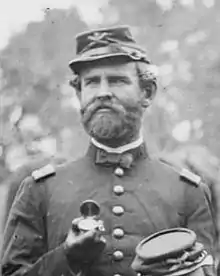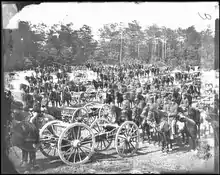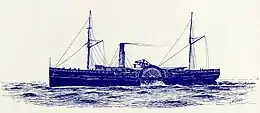Henry Benson (soldier)
Henry Benson (November 20, 1824 – August 11, 1862) was a career United States Army artillery officer who served in the Mexican–American War, Third Seminole War, and American Civil War with the 2nd U.S. Artillery. He sustained mortal wounds on August 5, 1862, during an engagement at Malvern Hill near the end of the Peninsula Campaign, and died several days later on August 11 while being transported north aboard the steamer S.R. Spaulding.
Henry Benson | |
|---|---|
 | |
| Born | November 20, 1824 Belleville, New Jersey |
| Died | August 11, 1862 (aged 37) At sea, aboard hospital ship S.R. Spaulding |
| Place of burial | |
| Allegiance | Union |
| Service/ | Union Army |
| Years of service | 1845–1862 |
| Rank | |
| Unit | 2nd U.S. Artillery |
| Commands held | Battery I, 2nd U.S. Artillery Battery E, 2nd U.S. Artillery |
| Battles/wars | Mexican–American War (WIA) Third Seminole War (WIA) American Civil War
|
Early life
Henry Benson was born in Belleville, New Jersey. He enlisted in the United States Army on June 6, 1845, at Fort Hamilton, New York.[1][2]
He served in the Mexican-American War with Major James Duncan's Battery A, 2nd U.S. Artillery, where he was frequently breveted for "good qualities" from the rank of private in 1845 through the rank of second lieutenant on June 28, 1848, later made permanent after the war on January 26, 1849.[3][4] Benson was present with Battery A at the battles of Palo Alto, Resaca de la Palma, Monterrey, Vera Cruz, and Churubusco. He rose to the rank of first sergeant in command of an artillery piece in Duncan's battery under section chief Lieutenant Henry Jackson Hunt at the siege of Mexico City, particularly active at the Battle of Chapultepec at the San Cosmé Garita.[2]
In the post-war years, Benson remained an officer of the 2nd U.S. Artillery serving with Batteries D and I, posted variously from New York, South Carolina, Michigan, Kansas, and Texas, as well as extensively throughout Florida. He was promoted to the rank of first lieutenant of Battery E, 2nd U.S. Artillery on March 2, 1853.[3][5][6]
In 1854, Benson was posted in Florida, participating in the Army's mission to survey the state and build roads, protect settlers, and relocate the indigenous Seminole tribe—all of which contributed to the Third Seminole War (1855–58).[7][8] Benson was heavily involved in the Army's surveying efforts, actively exploring rivers, scouting road paths in the field, alternately present at Fort Myers, Fort Meade, Fort Thompson, and Fort Center.[8][9][10][11] Arriving at Fort Center in April 1855, Benson noted his surroundings as "more disagreeable, unhealthy and devoid of interest than I had expected….Mosquitos awful. 1,000,000,000 of them….Hot– hot as fire all day."[12]
In 1855-56, Benson was often commander of the Battery E, 2nd U.S. while his commander was on sick leave. On August 2, 1856, the unit engaged the Seminoles at Punta Rassa, an action which concluded the regiment's duty in Florida. By the end of the year, all units were transferred back north, headquartered at Fort Hamilton, New York. In the following year, Battery E was posted to Fort Ontario, New York, Fort Mackinac, Michigan, and Fort Snelling, Minnesota, under the command of Captain Arnold Elzey.[6][7][13]
In 1857, Battery E, 2nd U.S. was sent to Kansas to assist in quelling unrest, headquartered at Fort Leavenworth. In 1859, Benson was transferred to command of Battery M, 2nd U.S. Artillery, also located at Fort Leavenworth.[7]
Civil War

Prior to the outbreak of the Civil War, Lieutenant Benson was transferred to Battery C, 2nd U.S. Artillery commanded by Captain Lewis G. Arnold, posted at Fort Independence, Massachusetts; in January 1861, Arnold's command was transferred to the unfinished Fort Jefferson, Florida, in order to aid in the preparation for war following the secession of Florida from the Union.[7][14] Benson was instrumental in assisting with the transfer of heavy artillery from Fort Taylor, Florida (under command of Captain John Milton Brannan) to arm Fort Jefferson—described by Arnold as "the key of the Gulf"— under the direction of Captain Montgomery C. Meigs.[14]
Benson was engaged in the preparations of Fort Jefferson when war broke out in April 1861.[6]
Fellow New Jersian artillerist Lieutenant Julius A. De Lagnel, whose second lieutenancy Benson succeeded in 1849, defected to the Confederate States in 1861.[7][15]
Benson was promoted to the rank of captain on May 14, 1861.[16] Following the First Battle of Bull Run in July 1861, Battery M, 2nd U.S. commander Major Henry J. Hunt was promoted to colonel as the Chief of Artillery for the defenses of Washington, D.C.,[17][18] and Benson was transferred to command of Battery M in September 1861.[1]
In November 1861, Battery M was converted to a horse artillery battery, equipped with six 3-inch Ordnance rifles.[7]
In 1862 Battery M moved with the Army of the Potomac into Virginia as part of Major General George B. McClellan's Peninsula Campaign (March–July 1862). Attached to the Artillery Reserve of the Army of the Potomac under Colonel Henry J. Hunt, Battery M was assigned to the First Brigade (U.S. Horse Artillery Brigade) under the command of Lieutenant Colonel William Hays. Benson led his unit effectively through the Siege of Yorktown, the Battle of Hanover Court House, and the Battle of Seven Pines (Fair Oaks Station).[19]
At Seven Pines on May 31, 1862, Benson reported that Battery M had a combined total strength of "four officers [including section chiefs Lieutenants Peter C. Hains, John W. Barlow, and Robert H. Chapin], 109 noncommissioned officers, mechanics, privates. . . . 141 horses, and six 3-inch rifled guns, with caissons and ammunition complete."[19]
Battery M was held in reserve at the beginning of the Seven Days Battles (June 25–July 1, 1862), stationed south of the Chickahominy River at Camp Lincoln near Savage's Station following previous detached service with Brigadier General Fitz John Porter's V Corps. The battery remained in camp during the battles of Beaver Dam Creek/Mechanicsville and Gaines' Mill, and was then deployed to cover the approaches of a bridge over the Chickahominy on June 28 during the V Corps' retreat south of the river; on June 29, the battery moved through the White Oak Swamp and was detailed to an advanced night reconnaissance with Colonel William Averell's 3rd Pennsylvania Cavalry beyond the Glendale crossroad, accompanying Brigadier General George A. McCall's Third Division, V Corps toward Malvern Hill, into the early morning of June 30; the battery moved on to Malvern Hill prior to the Battle of Glendale, but was hotly engaged the following day with the rest of the Horse Artillery Brigade during the Battle of Malvern Hill on July 1.[20][21]
For his service, Captain Benson was reported to be a favorite officer of General McClellan.[4]
Death

The Seven Days battles proved disastrous for the Army of the Potomac, and McClellan refused to take further offensive action from his position at the Union camp at Harrison's Landing on the James River without reinforcements. On August 3, 1862, McClellan was ordered by General-in-Chief Henry Halleck to retreat from the peninsula to Aquia Creek and terminate his campaign in order to meet up with the Army of Virginia under Major General John Pope—an order he only begrudgingly complied with nearly two weeks later.[22]
On August 5, 1862, in a second engagement at Malvern Hill, Virginia (not to be confused with the earlier Battle of Malvern Hill), Benson's Battery M, 2nd U.S., supported by Captain James M. Robertson's Battery B & L, 2nd U.S., engaged two regiments of Confederate infantry and an artillery battery in the early hours of the morning. Benson was mortally wounded during the fire when his leg was broken by a fragment from a burst artillery shell; it was reported to be from one of Battery M's own 3-inch Ordnance rifles.[4][23]
Benson was removed to the hospital transport steamship S.R. Spaulding for transport north to medical treatment, but died at sea of his wounds on August 11, 1862. His remains were returned to his hometown of Belleville, New Jersey and buried in the Belleville Dutch Reformed Churchyard on August 13, 1862.[4][24][25]
Legacy
In 1864, an artillery battery in defenses of Washington, D.C., was named Battery Henry Benson.[26]
An Endicott Era coast artillery battery at Fort Worden was named after Benson in 1904.[27]
A street in his hometown of Belleville is also named in his honor.[25]
References
- "Battery M, 2nd US Artillery". Crossed Sabers. 2008-09-29. Retrieved 2019-11-10.
- Gregory, V.J. (1976). Keepers at the Gate. Port Townsend, WA: Port Townsend Publishing Co., Inc. p. 119.
- Hamersly, Thomas Holdup Stevens (1888). Complete Army and Navy Register of the United States of America from 1776 to 1887. p. 296.
- "Obituary - Death of Captain Henry Benson, United States Army". The New York Herald. 1862-08-15. p. 5. ISSN 2474-3224. Retrieved 2019-11-10.
- Journal of the Executive Proceedings of the Senate of the United States of America. Vol. 9. Washington, D.C.: Government Printing Office. 1887. p. 55.
- Pierson, J. "Stirring the Blood of Friend and Foe to Admiration: Lieutenant Alanson M. Randol's Battery E & G, 1st U.S. at the Battle of Glendale, June 30, 1862". History Radar. Retrieved 2021-07-25.
- Simpson, W.A. (1896). "Second Regiment of Artillery". In Haskin, William L.; Rodenbough, Theophilus F. (eds.). The Army of the United States. Maynard, Merrill, & Co. pp. 312–27.
- Stone, Spessard. "Captain Francis Asbury Hendry". Retrieved 2019-11-12.
- Stone, Spessard. "Major General George Lucas Hartsuff". Retrieved 2019-11-11.
- Brown, Canter (1995). Fort Meade, 1849-1900. University of Alabama Press. p. 20. ISBN 978-0-8173-0763-9.
- Seley, Ray B., Jr. (1963). "Lieutenant Hartsuff and the Banana Plants" (PDF). Tequesta. Historical Association of Southern Florida: 5.
{{cite journal}}: CS1 maint: multiple names: authors list (link) - "History of Fisheating Creek". Florida Fish And Wildlife Conservation Commission. Retrieved 2019-11-12.
- Woltjer, Rodger (2018). Military History of the United States (Early Exploration through American Civil War). Hoosick Falls, NY: Merriam Press. p. 161. ISBN 9780359639724.
- The War of the Rebellion: A Compilation of the Official Records of the Union and Confederate Armies. 1. Vol. 1. Washington, D.C.: Government Printing Office. 1880. pp. 345–47.
- Senate, United States. Congress (1887). Journal of the Executive Proceedings of the Senate of the United States. p. 53.
- Diefendorf, Oliver; O'Brien, Thomas, eds. (1864). General Orders of the War Department, Embracing the Years 1861, 1862 & 1863. Vol. 1. New York: Derby & Miller. pp. 119.
- Hamersly, Thomas Holdup Stevens (1888). Complete Army and Navy Register of the United States of America, from 1776 to 1887. p. 529.
- Cullum, George W. (1891). "Henry J. Hunt". Biographical Register of the Officers and Graduates of the U.S. Military Academy. Vol. 2 (3 ed.). Boston: Houghton, Mifflin. pp. 9–10. ISBN 9780608428628.
- "Report of Henry Benson, May 31, 1862". War of the Rebellion: A Compilation of the Official Records of the Union and Confederate Armies. 1. Vol. 11. Washington, D.C.: Government Printing Office. 1884. pp. 694–95.
- "Report of Henry Benson, July 6, 1862". War of the Rebellion: A Compilation of the Official Records of the Union and Confederate Armies. 1. Vol. 11. Washington, D.C.: Government Printing Office. 1884. pp. 251–52.
- "Report of William Hays, July 7, 1862". War of the Rebellion: A Compilation of the Official Records of the Union and Confederate Armies. 1. Vol. 11. Washington, D.C.: Government Printing Office. 1884. pp. 242–43.
- "Report of Major-Gen. Halleck.; Headquarters of the Army, Washington, 1862". The New York Times. 1862-12-04. ISSN 0362-4331. Retrieved 2020-01-02.
- "A Movement in McClellan's Army". Scientific American. Vol. VII. no. 8. Scientific American. 1862-08-11. p. 114.
- "Steamship S.R. Spaulding". Retrieved 2019-11-10.
- "Honoring a long-ago local hero". The Observer Online. Belleville, NJ. 2017-08-09. Retrieved 2019-11-10.
- Townsend, E.D. (1863). "General Order 83" in General Orders of the War Department: Embracing the Years 1861, 1862 & 1863. Washington, D.C.: Derby & Miller. p. 91.
- "Battery Henry Benson". Coast Defense Study Group. Retrieved 2019-11-10.